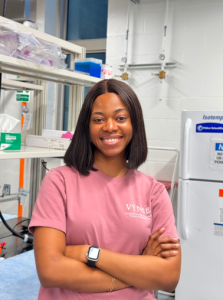Vivian Nwosu Madueke
Graduate Student, Interdisciplinary Materials Science
Silvera Batista Research Group
Mo st natural processes occur under conditions that are not in thermodynamic equilibrium but constantly experience flows of energy and matter. For instance, microorganisms survive by responding to dissipative chemical energies such as food in their environment by positive or negative chemotaxis. To enable the design of materials with unique properties, I decided to contribute to studies on synthetic systems pushed far away from equilibrium during my PhD journey at Vanderbilt, to access novel behaviors and functionalities not found in typical equilibrium states. Under external forces, colloidal systems are deterred from their characteristic Brownian state and can be directed in mannerisms useful in photonics, structural colors, and microfluidic applications.
st natural processes occur under conditions that are not in thermodynamic equilibrium but constantly experience flows of energy and matter. For instance, microorganisms survive by responding to dissipative chemical energies such as food in their environment by positive or negative chemotaxis. To enable the design of materials with unique properties, I decided to contribute to studies on synthetic systems pushed far away from equilibrium during my PhD journey at Vanderbilt, to access novel behaviors and functionalities not found in typical equilibrium states. Under external forces, colloidal systems are deterred from their characteristic Brownian state and can be directed in mannerisms useful in photonics, structural colors, and microfluidic applications.
In the Carlos Silvera Batista lab, we exploit electric fields for colloidal particle manipulation and behavioral studies, as electric fields have many tunable parameters that broaden the investigation landscape. At low electric field frequencies, charged colloidal particles levitate and transport over long distances to regions of energy minima. In these regions, particles experience attractive forces governed by flows that extend beyond the length scale of the van der Waals or electrostatic phenomena. This process is called electrodiffusiophoresis and my research aims to uncover and extend its possibilities. By electrodiffusiophoresis, an applied electric field induces a chemical gradient that directs colloidal particles. Hence, my investigation involves the simultaneous visualization of electrochemical reactions and the electrokinetic response of colloidal particles using confocal laser scanning microscopy. For an accurate quantitative description of chemical gradients, we employ ratiometric fluorescence, and to flexibly generate complex concentration profiles, we design and fabricate thin film electrodes.
The AJA sputtering equipment is my primary tool in the VINSE clean room, and it is used to fabricate oxide-based thin film electrodes with electronic properties I look out for that are tunable with deposition temperature. The surface morphology of each deposited batch is thereafter characterized by electron microscopy. The state-of-the-art fabrication and characterization possibilities at VINSE and Vanderbilt, coupled with the knowledgeable network of professionals, have been instrumental in the design and fruition of my experiments. It is always enriching to discuss project ideas and challenges with the faculty and technical crew associated with VINSE. Aside from one-on-one interactions, the regular VINSE seminars are another platform for engaging with diverse perspectives.